加拿大政府结构
加拿大的政治体制和社会制度研究

加拿大的政治体制和社会制度研究加拿大是一个民主、自治、联邦制的国家,其政治体制和社会制度因为其多元文化的特点而显得复杂和多样化,令人不得不加以研究。
政治体制加拿大采用的是议会制度,由联邦政府和10个省政府组成。
联邦政府(Canada government)分为三个分支:行政、立法和司法。
行政机构由总理和内阁组成。
总理是由国会议员选举产生的,由党派议会支持和建议选任内阁,内阁是总理选择的部长组成的。
这三个分支之间有权力的互相制约和平衡,实现了政治体制的稳定运行。
加拿大采用的是联邦制度,联邦政府和省政府在政治、经济、文化等领域都保持着一定的自治权。
联邦政府的事务涉及国家总体性问题,如国防、外交、移民等。
而省政府则承担地方性问题,如教育、医疗、社会福利等。
由于每个省的历史、文化、经济和人口等因素不同,因此各省之间的政治、经济、文化等差异也非常明显。
社会制度加拿大是一个多元文化的国家,其社会制度和生活方式也受到不同文化的影响。
加拿大是个福利国家,对病故、失业、老人、贫困和残疾人等方面都提供着社会保障。
而且,加拿大的医疗系统也是出了名的好,每个公民都可以享受到优质的医疗服务。
加拿大是一个民主国家,尊重言论自由和个人隐私,法律也保障公民的基本人权和自由。
此外,加拿大的教育也是著名的,经常在国际排名大赛中名列前茅。
加拿大有极高的教育水平,尤其是在艺术、文化、科学技术等领域。
同时,加拿大的社会各个阶层的关系也非常和谐,因为加拿大的历史和地理的原因产生的多民族、多文化的大熔炉,所以民族关系非常重要,这也使得加拿大的社会价值观强调多元化、包容性,人们习惯尊重多元文化。
结论加拿大的政治体制和社会制度在不断地发展和完善。
加拿大作为一个多元文化的国家,需要在政治、经济、文化、社会等方面不断进行改革,以适应国内外的新形势和新挑战,同时也需要在不断吸取国外发达民主国家的有益经验的前提下,建设一个更加繁荣、和谐和富有活力的社会和政治体制。
根据宪法加拿大实行联邦议会制

三文鱼
加拿大是世界主要的渔业国之一,三文鱼是
加拿大闻名世界的水产品之一。
守水待鱼
想啥来啥
进出口商品结构特点
相比其他发达国家,加拿大出口商品中,初
级产品占有重要地位。
社会制度
加拿大实行的是三权分立的政治制度。但加拿大 至今没有一部完整的宪法,主要由在各个不同历 史时期通过的宪法法案所构成。 根据宪法,加拿大实行联邦议会制,国家元首为 英国女王,由总督代表女王执掌国家的行政权。 总督由总理提名,女王任命。联邦议会是国家最 高权力和立法机构,由参议院和众议院组成,参 众两院通过的法案由总督签署后成为法律。总督 有权召集和解散议会。 政府为内阁制,是执行机构。由众议院中占多数 席位的政党组阁,其领袖任总理,领导内阁。
枫糖
枫糖是“枫叶之国”加拿大最具代表性的特色产品之一 。 糖枫,是一种高大落叶乔木。高达40米,径40一100cm,树 龄可达500年。树干中含大量淀粉,冬天成为蔗糖。天暖蔗糖 变成香甜的树液。如在树上钻孔,树液便源源流出。树汁熬 制成的糖叫枫糖或槭糖。
枫糖含有丰富的矿物质、有机酸,热量比蔗糖、果糖、玉米 糖等都低,但是它所含的钙、镁和有机酸成分却比其它糖类 高很多,能补充营养不均衡的虚弱体质。枫糖的甜度没有蜂 蜜高,糖分含量约为66%(蜂蜜含糖量约79%—81%﹐砂糖高 达99.4%)。
加拿大概况
加拿大位于北美洲北部。东临大西洋,西濒
太平洋,西北部邻美国阿拉斯加州,东北与 格陵兰(丹)隔戴维斯海峡遥遥相望,南接 美国本土,北靠北冰洋达北极圈。海岸线约 长24万多公里。东部气温稍低,南部气候适 中,西部气候温和湿润,北部为寒带苔原气 候。中西部最高气温达40℃以上,北部最低 气温低至-60℃。加拿大是世界上海岸线最长 的国家,是世界上领土面积第二大国家
加拿大政治、价值观
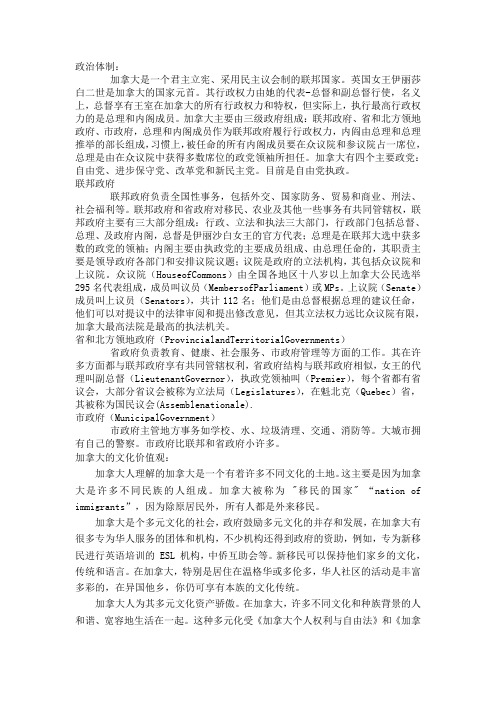
政治体制:加拿大是一个君主立宪、采用民主议会制的联邦国家。
英国女王伊丽莎白二世是加拿大的国家元首。
其行政权力由她的代表-总督和副总督行使,名义上,总督享有王室在加拿大的所有行政权力和特权,但实际上,执行最高行政权力的是总理和内阁成员。
加拿大主要由三级政府组成:联邦政府、省和北方领地政府、市政府,总理和内阁成员作为联邦政府履行行政权力,内阎由总理和总理推举的部长组成,习惯上,被任命的所有内阁成员要在众议院和参议院占一席位,总理是由在众议院中获得多数席位的政党领袖所担任。
加拿大有四个主要政党:自由党、进步保守党、改革党和新民主党。
目前是自由党执政。
联邦政府联邦政府负责全国性事务,包括外交、国家防务、贸易和商业、刑法、社会福利等。
联邦政府和省政府对移民、农业及其他一些事务有共同管辖权,联邦政府主要有三大部分组成:行政、立法和执法三大部门,行政部门包括总督、总理、及政府内阁,总督是伊丽沙白女王的官方代表;总理是在联邦大选中获多数的政党的领袖;内阁主要由执政党的主要成员组成、由总理任命的,其职责主要是领导政府各部门和安排议院议题;议院是政府的立法机构,其包括众议院和上议院。
众议院(HouseofCommons)由全国各地区十八岁以上加拿大公民选举295名代表组成,成员叫议员(MembersofParliament)或MPs。
上议院(Senate)成员叫上议员(Senators),共计112名;他们是由总督根据总理的建议任命,他们可以对提议中的法律审阅和提出修改意见,但其立法权力远比众议院有限,加拿大最高法院是最高的执法机关。
省和北方领地政府(ProvincialandTerritorialGovernments)省政府负责教育、健康、社会服务、市政府管理等方面的工作。
其在许多方面都与联邦政府享有共同管辖权利,省政府结构与联邦政府相似,女王的代理叫副总督(LieutenantGovernor),执政党领袖叫(Premier),每个省都有省议会,大部分省议会被称为立法局(Legislatures),在魁北克(Quebec)省,其被称为国民议会(Assemblenationale).市政府(MunicipalGovernment)市政府主管地方事务如学校、水、垃圾清理、交通、消防等。
加拿大政治制度

加拿大政治制度加拿大政治制度是一个以议会制为主的民主政治制度。
加拿大政府的权力分为三个层级:联邦政府、省政府和地方政府。
以下是对加拿大政治制度的概述:1. 联邦政府:加拿大联邦政府是由国会制度组成的,国会分为两个议院:下议院(众议院)和上议院(参议院)。
下议院的议员由全国各地的选民选举产生,而上议院的议员则是由总理任命。
联邦政府负责处理国家事务,如国防、外交和宪法事务等。
2. 省政府:加拿大有十个省和三个地区,每个省和地区都有自己的省政府,通过省议会来处理地方事务。
省政府负责地方教育、卫生、交通和经济等事务,享有相对较大的自治权。
3. 地方政府:加拿大的地方政府是在省政府之下的最低一级政府,包括城市、县和乡镇。
地方政府负责处理地方事务,如城市规划、土地管理和基础设施建设等。
4. 选举制度:加拿大的选举制度是多党制,选民通过投票选举议员和政府。
联邦选举和省选举的选举程序是类似的,选民根据选区选举对应的议员。
联邦选举和省选举一般每四年进行一次。
5. 宪法:加拿大的宪法是加拿大的最高法律,规定了政府的权力和限制。
目前加拿大没有单独的宪法文件,宪法通过一系列法律和文件来确立,其中包括1982年通过的加拿大宪法法案。
6. 皇室:加拿大是英国的联邦领地,英国君主是加拿大的国家元首。
君主的角色主要是象征性的,实际上许多权力已经转移到了议会和政府手中。
总的来说,加拿大的政治制度是一个多层次的、民主的政治制度。
联邦政府、省政府和地方政府各司其职,共同参与国家和地方事务的决策和管理。
选举制度保障了选民的权力和选择权。
加拿大的政治制度建立了一套相对稳定和有效的治理机制,为国家的发展和民众的福祉提供了保障。
加拿大缩写
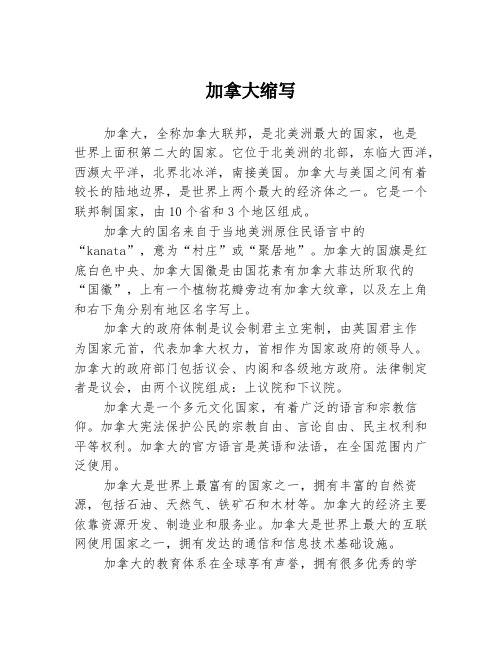
加拿大缩写加拿大,全称加拿大联邦,是北美洲最大的国家,也是世界上面积第二大的国家。
它位于北美洲的北部,东临大西洋,西濒太平洋,北界北冰洋,南接美国。
加拿大与美国之间有着较长的陆地边界,是世界上两个最大的经济体之一。
它是一个联邦制国家,由10个省和3个地区组成。
加拿大的国名来自于当地美洲原住民语言中的“kanata”,意为“村庄”或“聚居地”。
加拿大的国旗是红底白色中央、加拿大国徽是由国花素有加拿大菲达所取代的“国徽”,上有一个植物花瓣旁边有加拿大纹章,以及左上角和右下角分别有地区名字写上。
加拿大的政府体制是议会制君主立宪制,由英国君主作为国家元首,代表加拿大权力,首相作为国家政府的领导人。
加拿大的政府部门包括议会、内阁和各级地方政府。
法律制定者是议会,由两个议院组成:上议院和下议院。
加拿大是一个多元文化国家,有着广泛的语言和宗教信仰。
加拿大宪法保护公民的宗教自由、言论自由、民主权利和平等权利。
加拿大的官方语言是英语和法语,在全国范围内广泛使用。
加拿大是世界上最富有的国家之一,拥有丰富的自然资源,包括石油、天然气、铁矿石和木材等。
加拿大的经济主要依靠资源开发、制造业和服务业。
加拿大是世界上最大的互联网使用国家之一,拥有发达的通信和信息技术基础设施。
加拿大的教育体系在全球享有声誉,拥有很多优秀的学校和大学。
加拿大的医疗保健系统是由公立和私立机构组成的,全民享有医疗保险。
加拿大的旅游业发达且多样化,吸引了来自世界各地的游客。
加拿大以其壮丽的自然风光著名,其中包括洛矶山脉、尼亚加拉瀑布和不列颠哥伦比亚省的温哥华等。
加拿大还有许多著名的城市,如多伦多、渥太华、蒙特利尔和温哥华等。
总结起来,加拿大是一个富饶而多元的国家,拥有优美的自然风光、发达的经济和完善的社会福利制度。
加拿大在国际上扮演着重要的角色,是一个安全、繁荣和宜居的国家。
《加拿大》教案:了解加拿大的政治制度

《加拿大》教案:了解加拿大的政治制度。
一、加拿大的政治制度1.政治体制加拿大是一个君主立宪制国家,英国女王伊丽莎白二世是加拿大的元首。
加拿大的国家机构由国王、议会和内阁等组成。
议会由上议院和下议院两个分支构成,总理是下议院的领袖,由议会选举产生。
加拿大的司法系统独立于政府,美国、英国的法律体系都在其中有所影响。
加拿大的司法体制由省份法院和联邦法院两大类组成,这意味着任何一名加拿大公民都可通过联邦或省法院救济。
2.政治体制理念加拿大的政治制度体现了一系列独特的理念。
其中最基本的原则是宪政民主,即权力受限制的民主,这意味着权力不是由国王或政府自行掌握,而是必须受到宪法的约束。
除此之外,加拿大的政治制度还贯穿了“千岛之国”、“多元文化”、“弱势群体”等理念。
加拿大的政治体制通过行政法规或司法判决的方式,为公民的权利和平等做出保障,这意味着公民在社会和政治生活中有着更大的自由和权力。
3.政治制度特点加拿大的政治制度具有以下特点:(1)行政和立法机构独立。
加拿大的政治制度中,不存在美国那样的总统行政权和国会立法权的权力配置,执行和立法机构是相对独立的。
(2)议会选举制度。
加拿大的议会选举采用单一选区制和比例代表制结合的方式。
每个选区只能选一名议员,然而某些选区可以支配多名议员。
(3)统一性和联邦性。
加拿大的政治制度既要保持全国性,又有要保持地方性,因此对于整体和部分的协调是一个长期面临的难点。
(4)政治家之间部分独立。
加拿大政治体制的一个重要特点是,政治家不会曾把自己的职位当成其他职业的“投资”,他们更注重其自身的公共生涯和价值观。
二、加拿大政治制度的优势1.运作稳定加拿大的政治制度保持了长期稳定,这要部分归功于其君主立宪制的性质,同时也归功于议员和内阁之间独立的关系,避免了某些政治家个人行为带来的影响与干扰,从而使政治体系的运作更加稳定。
2.保证个人权利与自由加拿大的政治体制强调了个人权利和自由,通过宪法和司法制度来保护公民的基本权利,实现了政治体制的透明度和公正性,可以为公民提供基本的防御权力,实现基本的民主价值。
加拿大行政区划详细介绍

加拿大行政区划详细介绍加拿大是世界上面积第二大的国家,国土面积为9,984,670平方公里(加拿大统计局数据),比中国的面积大三十多万平方公里。
在这么广袤的国土上居住的人口却非常稀少,2011年统计结果为33,476,688,仅为中国人口的1/40。
如果加拿大按照中国划分省级行政单位所采用的面积大小来分省的话,那加拿大也得有三十多个啥省吧。
但不知为什么原因,英国人当初给加拿大分块的时候却极其地大手大脚,虽然经过多年发展,目前也只有10个省(province)和3个地区(territory)。
省和地区的主要区别是:省是根据宪法设立的,其事务基本由省政府自治;地区是根据联邦法律设立的,其事务则由联邦政府直接管理。
或许是因为加国人口太少,省份搞得太多的话弄出太多只有几万人的省就太过浪费行政资源了吧。
因为我是广东省过来的,就拿广东的陆地面积、人口等数据和加拿大的各省情况做些简单的对比,这样容易对加拿大地广人稀的情况有个比较感性的认识。
1、British Columbia(不列颠哥伦比亚省或英属哥伦比亚省),简称BC 省,成立于1871年。
根据字母BC的发音,粤语又把BC省翻作卑诗省。
位于太平洋东岸,BC省的东面为Alberta省,北面为育空地区和西北地区,南接美国的华盛顿州、爱达荷州和蒙大拿州。
支柱产业为采矿、森林、服务业和渔业。
该省陆地面积为922,509平方公里,在加国排第5;人口4,400,057(人口数据除注明外均取自加拿大统计局2011年人口普查数据,下同),在加国排第3。
按照广东省的面积为179,800平方公里计算,大约相当于5.3个广东省的面积大小;按广东省人口1亿零430万(2010年中国人口普查数据)计算,大约相当于广东人口的1/23。
该省人口密度为4.8人/平方公里;广东省的人口密度达到580人/平方公里,约为BC省的120倍。
BC省的省会为维多利亚(Victoria),市区人口80,017,在加拿大排名第67。
加拿大做为一个联邦国家,它的政治体制是怎么构成的?

加拿大做为一个联邦国家,它的政治体制是怎么构成的?其实,加拿大体制上是英国体制、美国体制、本土特色三种并存的状态。
与其他英联邦国家不同,加拿大的政体极具特色。
名义上,它是君主立宪制,因为它有一个女王作为自己的国家元首;实际上,它实行的是议会民主制,由立法、行政、司法三个权力机构组成。
同时,它又是一个联邦制国家,联邦政府即中央政府与省政府分享权力。
具体大家可以了解到这些:总督加拿大是英联邦国家之一,英国女王是名义上的国家领袖,总督是名义领袖的代表,由英国女王任命。
现在总督一般是加拿大人。
总督职责包括:召集或解散议会,主持总理、最高大法官、内阁和枢密院的就职仪式,统帅三军。
实际上总督权力受到宪法很大的限制,根据加拿大宪法,总督召集或解散议会必须在总理的提议下进行,其职责的履行必须遵循各有关部长的建议。
枢密院它是一个向政府提供“援助”和“咨询”的荣誉机构,其成员由总理推荐、总督任命,包括执政的总理和内阁成员、前任的总理和内阁成员、前任与现任的大法官等,任期终生。
政府总理执政党领袖。
执政党指在国会大选中获胜,占大多数席位的政党。
总理权力很大,除组建政府还建议总督人选、国会的解散等。
总理的任期也不固定,只要其党仍为执政党。
政府内阁政府各部部长构成内阁,通常是众议院议员,少数来自参议院。
总理在选择内阁成员时重视地区平衡,使每个地区在政府中都有利益代表。
内阁主要是确定政府各项任务并制定相应的政策、考虑和批准每项立法。
政府各部部长只对民选的众议院负责。
加拿大立法机构联邦立法权由参议院和众议院控制。
两院都能提出法案,公众法案多由众议院提出,私人法案多由参议院提出,但有关公款使用、征税及关税等只能由众议院提出。
众议院提出法案后须在该院经三轮宣读通过后提交参议院,参议院再经类似程序通过后由总督或大法官批准,法案就正式成为法律。
参议院提出法案也要经过同样程序。
众议院现有282个席位,按人口分配席位,人口越多、席位越多。
加拿大政府结构(精)
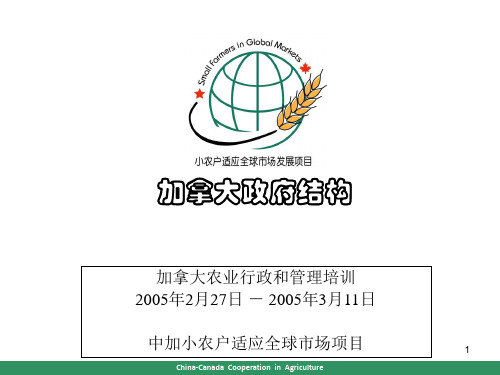
12
China-Canada Cooperation in Agriculture
政府结构
• 政府综合部门:
– 枢密院办公室 – 财政部 – 国库部秘书处 – 外交部
13
China-Canada Cooperation in Agriculture
政府结构
• 枢密院办公室
– – – – – 总理负责的“部” 协调所有内阁业务 解决部长之间的问题 准备每个议会开始时的国情咨文 管理“政府机器”
政府结构
• 内阁:
– 由总理负责 – 由内阁所有部长和参议院Hale Waihona Puke 政府领导人组成 – 内阁有多个委员会
• 内阁结构和运行由总理决定
– 与中国的国务院相似
10
China-Canada Cooperation in Agriculture
政府结构
• 本届的内阁委员会
– 运行 – 国库部
• 费用审查
– – – – – –
– 魁北克集团(Gilles Duceppe) – 新民主党(Jack Layton)
6
China-Canada Cooperation in Agriculture
政府结构
• 内阁部长:
– 由总理推荐,总督批准 – 通常是选举产生的众议院议员 – 包括参议院的政府领导人 – 负责总理要求的或立法中规定的立法
15
China-Canada Cooperation in Agriculture
政府结构
• 国库部秘书处:
– 提出年度拨款法案,制定本年支出条例和限额 – 批准政府计划的具体内容和费用支出 – 指导审计和评估 – 所有的联邦公务员的官方“雇主” – 与雇员协商工资,福利和工作条件 – 谈判政府的服务合同 – 管理和监督政府各部门的总体运行条例
加拿大制度

加拿大制度加拿大的制度体系包括政治制度、经济制度、教育制度、医疗制度等多个方面。
下面将重点介绍加拿大的政治制度和经济制度。
加拿大政治制度是民主制度,采取君主立宪制。
加拿大是一个联邦制国家,由10个省份和3个地区组成。
国家最高权力机构是国会,包括国王(或女王)、上议院和下议院。
国王作为君主担任国家元首的职位,但并不实际行使行政权力,而是由总督代表君主行使职权。
上议院由任命产生的参议员组成,其主要职责是审查和修正法律法规。
下议院由选举产生的议员组成,其主要职责是立法,代表选民的意愿。
加拿大的选举制度是多党制,主要有保守党、自由党和新民主党三大主要政党。
选举由选民直接选举国会议员,选举周期为四年。
选民必须年满18岁,具有加拿大国籍和居住在选区内方可参加选举。
选举结果将决定国会的组成和议会的政策方向。
加拿大的经济制度是市场经济,不过政府对经济活动有一定的干预。
加拿大是世界上最富有的国家之一,其主要经济支柱包括矿业、制造业、能源、农业和服务业。
加拿大拥有丰富的自然资源,如石油、天然气、煤炭、金属矿石等,这些资源的开采和加工对经济发展起到了重要作用。
制造业在加拿大的经济中也占有重要地位,主要包括汽车、航空航天、电子、化工等行业。
加拿大的农业主要以农作物和畜牧业为主,如小麦、玉米、大豆、牛肉、鸡肉等。
服务业发展迅速,包括金融、保险、教育、医疗、旅游等行业。
加拿大的社会福利制度比较完善,包括医疗保障、社会保险、养老金等。
医疗保健是由省级政府和联邦政府共同负责的,具有普及性和平等性。
社会保险主要包括失业保险、健康保险和养老金等,以确保公民在面临不幸或退休时能够获得基本的保障和福利。
总之,加拿大的制度体系是建立在民主和市场经济基础上的。
政治制度体现了多党制和联邦制的特点,经济制度以市场经济为主导,但政府对经济活动有一定的干预。
加拿大的制度体系为国家的发展和公民的福祉提供了坚实的基础。
19世纪加拿大责任制政府的形成
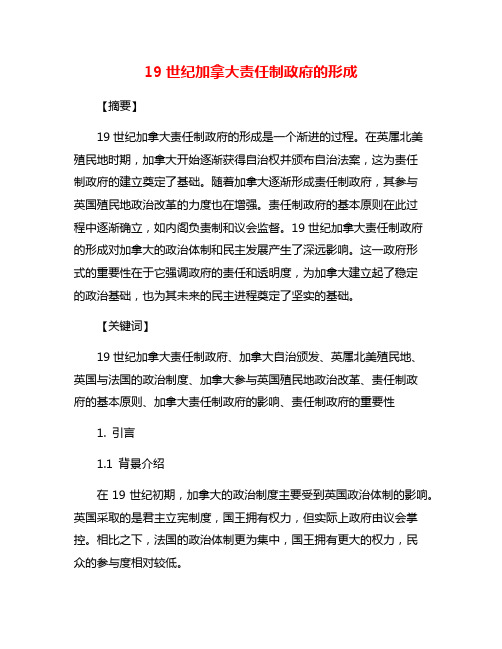
19世纪加拿大责任制政府的形成【摘要】19世纪加拿大责任制政府的形成是一个渐进的过程。
在英属北美殖民地时期,加拿大开始逐渐获得自治权并颁布自治法案,这为责任制政府的建立奠定了基础。
随着加拿大逐渐形成责任制政府,其参与英国殖民地政治改革的力度也在增强。
责任制政府的基本原则在此过程中逐渐确立,如内阁负责制和议会监督。
19世纪加拿大责任制政府的形成对加拿大的政治体制和民主发展产生了深远影响。
这一政府形式的重要性在于它强调政府的责任和透明度,为加拿大建立起了稳定的政治基础,也为其未来的民主进程奠定了坚实的基础。
【关键词】19世纪加拿大责任制政府、加拿大自治颁发、英属北美殖民地、英国与法国的政治制度、加拿大参与英国殖民地政治改革、责任制政府的基本原则、加拿大责任制政府的影响、责任制政府的重要性1. 引言1.1 背景介绍在19世纪初期,加拿大的政治制度主要受到英国政治体制的影响。
英国采取的是君主立宪制度,国王拥有权力,但实际上政府由议会掌控。
相比之下,法国的政治体制更为集中,国王拥有更大的权力,民众的参与度相对较低。
加拿大的政治发展受到英国和法国两种政治体制的影响。
英国的议会制度为加拿大提供了一个参考,人民渴望加强议会的权力,实现政治民主和自主。
与此法国的集中式政治制度也让加拿大人认识到了权力的过度集中可能导致的问题,加深了他们对权力分散和负责制度的向往。
在这样的背景下,加拿大逐渐走向了自治和责任制政府的道路。
这些变化不仅影响了加拿大的政治体制,也对整个国家的发展产生了深远影响。
这一部分将为我们后续对19世纪加拿大责任制政府形成的探讨提供重要的背景资料。
1.2 对比英国与法国的政治制度英国和法国是欧洲两大历史悠久的国家,其政治制度也有着显著的差异。
在19世纪,英国已经建立了相对成熟的责任制政府,实行议会制度,国王只是象征性的元首,权力主要由议会掌握。
英国的政府稳定、秩序良好,国家发展相对较快。
而在对比之下,当时的法国政治制度相对混乱,受到封建王朝的束缚,国王的权力较大,政府运作效率不高,经济发展也相对滞后。
加拿大为什么只有总理,没有国家总统
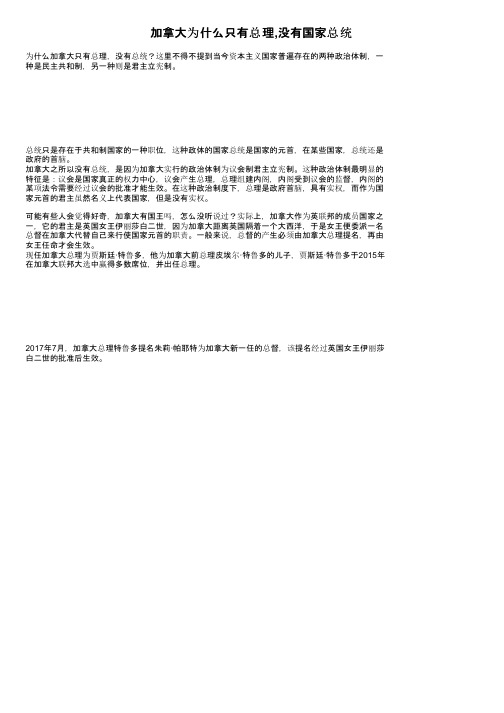
加拿大为什么只有总理,没有国家总统
为什么加拿大只有总理,没有总统?这里不得不提到当今资本主义国家普遍存在的两种政治体制,一种是民主共和制,另一种则是君主立宪制。
总统只是存在于共和制国家的一种职位,这种政体的国家总统是国家的元首,在某些国家,总统还是政府的首脑。
加拿大之所以没有总统,是因为加拿大实行的政治体制为议会制君主立宪制。
这种政治体制最明显的特征是:议会是国家真正的权力中心,议会产生总理,总理组建内阁,内阁受到议会的监督,内阁的某项法令需要经过议会的批准才能生效。
在这种政治制度下,总理是政府首脑,具有实权,而作为国家元首的君主虽然名义上代表国家,但是没有实权。
可能有些人会觉得好奇,加拿大有国王吗,怎么没听说过?实际上,加拿大作为英联邦的成员国家之一,它的君主是英国女王伊丽莎白二世,因为加拿大距离英国隔着一个大西洋,于是女王便委派一名总督在加拿大代替自己来行使国家元首的职责。
一般来说,总督的产生必须由加拿大总理提名,再由女王任命才会生效。
现任加拿大总理为贾斯廷·特鲁多,他为加拿大前总理皮埃尔·特鲁多的儿子,贾斯廷·特鲁多于2015年在加拿大联邦大选中赢得多数席位,并出任总理。
2017年7月,加拿大总理特鲁多提名朱莉·帕耶特为加拿大新一任的总督,该提名经过英国女王伊丽莎白二世的批准后生效。
加拿大总统

加拿大总统加拿大总统,加拿大政府的最高领导人,担任着重要的职责和责任。
作为一个重要的国家元首,加拿大总统在政治、经济和外交等方面发挥着重要的作用。
以下将对加拿大总统的职责、权力和责任进行详细介绍。
加拿大总统是加拿大政府的首脑,由国会议员在议会中选举产生。
总统是加拿大政府三个机构(行政、立法和司法)中的行政机构的负责人。
总统主要负责国家的各项政策、法律和行政事务的制定和执行,并代表加拿大政府与其他国家进行外交交往。
总统还负责决策和批准国内外的军事行动,保障国家的安全和稳定。
总统的权力和责任在加拿大政府中被明确规定。
首先,总统具有内阁成员的指派权。
总统经过内阁成员的推荐,任命各部门的部长,确保政府的正常运转。
其次,总统有权解散国会,决定议会选举的时间。
总统可以根据国家的需要,提前解散国会,重新选举新一届国会议员。
同时,总统还负责国会议员的召集,定期进行议会会议。
此外,总统有权通过签署法案将其转变为正式的法律,并发布相关的行政命令和公告。
与此同时,总统还有一些非正式的权力和责任。
总统作为国家元首,负有维护国家的尊严、地位和形象的责任。
总统代表加拿大政府与其他国家的领导人进行会晤和交流,加强国家之间的友好关系和合作。
此外,总统还经常参加各类重要的国内外仪式和活动,展示国家的风采和力量。
加拿大总统的职责和责任十分重要,对于国家的政治和发展具有重要影响。
总统在制定和执行政策时需要综合考虑国内外的各种因素和条件,通过与各部门和利益相关方的协商和合作,准确地把握国家的发展方向和政策导向。
总统还需要保持与国会议员和政府官员的良好沟通和合作关系,确保政府的工作能够顺利进行。
总之,加拿大总统担任着国家元首和政府首脑的角色,负有重要的权力和责任。
总统在国家政务、外交事务和决策等方面发挥着重要的作用。
总统的职责包括政府的运作、法律的制定和执行、决策权的行使等。
总统需要具备较高的能力和素质,为国家的发展和繁荣贡献自己的力量。
加拿大地方政府的行政架构与规划体系——以安大略省为例

加拿大地方政府的行政架构与规划体系——以安大略省为例作者:印晓晴来源:《上海城市规划》 2018年第1期1 概况加拿大位于北美洲(图1),行政区划为10个省(Province)和3个领地(Territory),国土面积约为998万km2,其中水域面积约89万km2。
总人口约3 300万人,其中约90%人口分布于与美国接壤的160 km范围内(图2)。
加拿大有2 000个自治市(Municipality),城镇化率为98%。
2013年,加拿大国内生产总值(GDP)初值为1.89万亿加元,人均5.39万加元,同年安大略省的国内生产总值(GDP)初值为0.70万亿加元,占加拿大总额的36.74%,人均4.64万加元。
首府位于多伦多的安大略省(Ontario)是加拿大经济最发达且最具活力的地区[1],其陆地面积为89万km2,占全国陆地面积的9%,而全省人口为1 290万人,占全国总人口的39%。
其中乡村农业人口自2001年以来下降了5.40%,为17.90万人,占全省总人口的1.38%(图3)。
2 地方政府加拿大为联邦制国家,下设省和自治市两级行政管理,各级政府独立选举产生。
加拿大的自治市按结构体系分为两类:一类为高层和底层组成的双层结构,所谓高层自治市(UpperTier Municipality),包括郡(County)、地区(Region)、和大都会区(Metropolitan Area)。
所谓底层自治市(Lower Tier Municipality),包括市(City)、镇(Town)、村(Villages)和小镇(Townships);另一类为单层结构,单层自治市(Single TierMunicipality)的功能与责任是高层自治市和底层自治市的结合(图4)。
安大略省共有444个自治市,占到全国自治市的22%。
其中,高层自治市30个,底层自治市241个,单层自治市173个。
城市密度平均约每2 000 km2一个自治市[3]。
犀牛手札354:加拿大的三级政府+加拿大怎么这么慢?
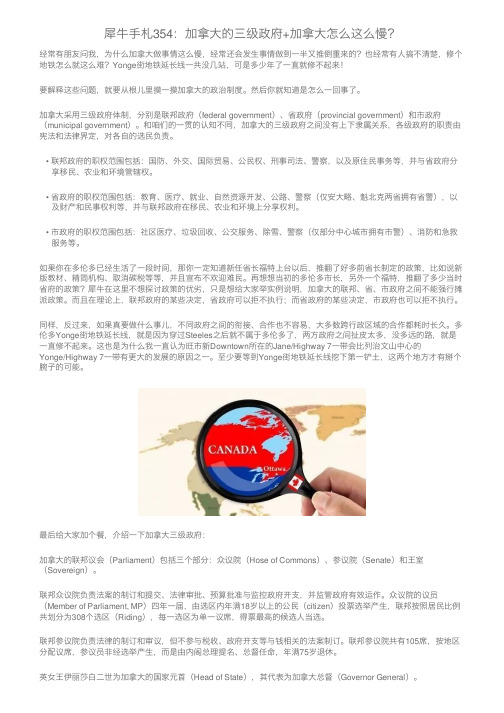
犀⽜⼿札354:加拿⼤的三级政府+加拿⼤怎么这么慢?经常有朋友问我,为什么加拿⼤做事情这么慢,经常还会发⽣事情做到⼀半⼜推倒重来的?也经常有⼈搞不清楚,修个地铁怎么就这么难?Yonge街地铁延长线⼀共没⼏站,可是多少年了⼀直就修不起来!要解释这些问题,就要从根⼉⾥摸⼀摸加拿⼤的政治制度。
然后你就知道是怎么⼀回事了。
加拿⼤采⽤三级政府体制,分别是联邦政府(federal government)、省政府(provincial government)和市政府(municipal government)。
和咱们的⼀贯的认知不同,加拿⼤的三级政府之间没有上下⾪属关系,各级政府的职责由宪法和法律界定,对各⾃的选民负责。
•联邦政府的职权范围包括:国防、外交、国际贸易、公民权、刑事司法、警察,以及原住民事务等,并与省政府分享移民、农业和环境管辖权。
•省政府的职权范围包括:教育、医疗、就业、⾃然资源开发、公路、警察(仅安⼤略、魁北克两省拥有省警),以及财产和民事权利等,并与联邦政府在移民、农业和环境上分享权利。
•市政府的职权范围包括:社区医疗、垃圾回收、公交服务、除雪、警察(仅部分中⼼城市拥有市警)、消防和急救服务等。
如果你在多伦多已经⽣活了⼀段时间,那你⼀定知道新任省长福特上台以后,推翻了好多前省长制定的政策,⽐如说新版教材、精简机构、取消碳税等等,并且宣布不欢迎难民。
再想想当初的多伦多市长,另外⼀个福特,推翻了多少当时省府的政策?犀⽜在这⾥不想探讨政策的优劣,只是想给⼤家举实例说明,加拿⼤的联邦、省、市政府之间不能强⾏摊派政策。
⽽且在理论上,联邦政府的某些决定,省政府可以拒不执⾏;⽽省政府的某些决定,市政府也可以拒不执⾏。
同样,反过来,如果真要做什么事⼉,不同政府之间的衔接、合作也不容易,⼤多数跨⾏政区域的合作都耗时长久。
多伦多Yonge街地铁延长线,就是因为穿过Steeles之后就不属于多伦多了,两⽅政府之间扯⽪太多,没多远的路,就是⼀直修不起来。
加拿大政府结构(精)

2
China-Canada Cooperation in Agriculture
政府结构
• 加拿大:两院议会民主体制 • 国家元首:总督 Adrienne Clarkson (伍冰枝) 阁下
– 英女王在加拿大的代表 – 由本届政府总理提名女王批准 – 官方称呼,总督
政府结构
• 内阁:
– 由总理负责 – 由内阁所有部长和参议院的政府领导人组成 – 内阁有多个委员会
• 内阁结构和运行由总理决定
– 与中国的国务院相似
10
China-Canada Cooperation in Agriculture
政府结构
• 本届的内阁委员会
– 运行 – 国库部
• 费用审查
– – – – – –
• 总理:Paul Martin 保罗.马丁阁下
– – – – – 由政党选择 赢得加拿大某一个选区 在大选后由总督任命组成政府 通常是在议会占有最多席位的政党的领袖 为政府首脑
3
China-Canada Cooperation in Agriculture
政府结构
• 两院制议会:
– 众议院
• 议员由全加的各个选区选出 • 共308席(代表选区),一个空缺 • 众议院议长:由众议员选举产生
20
China-Canada Cooperation in Agriculture
政府结构
• 农业和农业食品部:
– 加拿大食品检验署
• 执行加拿大卫生部制定的食品安全和营养质量标准,制定和检 查执行动物健康和植物保护的标准
– – – – – – 联邦肉品检验 对国外昆虫和疾病进行边界检验 防止对食品进行欺骗性标识 对动物进行人道运输 食品调查和召回 对种子,饲料,肥料和植物进行实验室检测
别具一格的加拿大政党制

别具⼀格的加拿⼤政党制2019-09-29加拿⼤第41届联邦议会选举5⽉2⽇当晚揭晓:斯蒂芬·哈珀领导的保守党赢得众议院过半数议席,实现连续三届执政,并将⾸次组成多数府;杰克·莱顿领导的新⼀跃成为第⼆⼤党;⽽此前最⼤反对党⾃由党和魁北克集团,则经历了各⾃最⼤的失败。
这是加拿⼤7年来第四次⼤选。
今年3⽉,哈珀因新预算不透明被在野三党以“藐视”议会的理由赶下台。
不过,哈珀也可能是故意找借⼝提前⼤选。
其于选后在家乡艾伯塔省发表胜选感⾔时说,选民的⽀持使加拿⼤摆脱了持续不断进⾏选举的困局,掀开了稳定发展的新篇章。
⽽此前加拿⼤之所以频出少数府,很⼤程度上与它的竞争性两个半政党制有关。
两个半政党制加拿⼤⾃1867年建⽴联邦以来,⾃由党和保守党主导了联邦政治,形成了两党轮流执政的局⾯。
虽然这种格局在上世纪20~30年代有所波动,许多⼩党还曾长期控制某些省的政府,但在联邦⼀级,并没有出现第三党出⾯组阁的情形。
这次新搅局成功,主要是侵蚀了⾃由党和魁北克集团的选区,并没有撼动保守党的执政地位。
实际上,⾃上世纪20年代起,加拿⼤⼀直存在所谓的第三党运动。
进⼊新世纪,像新这样的第三党不仅多次在少数府时期扮演重要的平衡⾓⾊,给加拿⼤政治⽣活添加了激进的左翼声⾳,⽽且以⼯会底⾊弥补了两⼤传统政党主要代表⼯商业集团的局限性。
但是,要加拿⼤⼈接受⼀个宣扬民主社会主义的政党上台,却也不那么容易。
从加拿⼤联邦议会长期由两⼤党控制和第三党居间发挥独特作⽤的历史来看,加拿⼤政党制可归为介于两党制和多党制之间的两个半政党制。
尽管这次⼤选⾃由党惨败,但从其⽣命⼒看,不太可能步⼀战后英国⾃由党⼀蹶不振的后尘。
加拿⼤历史上,以农民为基础的进步党也曾跃居联邦众院第⼆⼤党,但属于昙花⼀现。
即便今后新能扮演英国⼯党的⾓⾊,监督保守党的执政,⾃由党也不会彻底边缘化,加拿⼤政坛仍将呈现两个半党制的特⾊。
加拿⼤特殊的两个半政党制,是在与其它相关政治制度的互动中形成的。
- 1、下载文档前请自行甄别文档内容的完整性,平台不提供额外的编辑、内容补充、找答案等附加服务。
- 2、"仅部分预览"的文档,不可在线预览部分如存在完整性等问题,可反馈申请退款(可完整预览的文档不适用该条件!)。
- 3、如文档侵犯您的权益,请联系客服反馈,我们会尽快为您处理(人工客服工作时间:9:00-18:30)。
Produced by the Portfolio Affairs Office Department of Canadian Heritage April 2002Reprinted and updated February 2009 www.pch.gc.caCatalogue No.: CH4-136/2008E-PDF ISBN 978-1-100-11529-0T ABLE OF C ONTENTS Introduction (1)1. What’s Different about Public Institutions (2)2.The Concept of the Crown (3)3.The Concept of the Portfolio (5)4.Types of Government Organizations (7)Departments (7)Departmental agencies and other organizations (7)Crown corporations (7)Arm’s-length principle (8)5.Planning, Budgeting and Accountability Regime (9)Part I – The Government Expenditure Plan (9)Part II – The Main Estimates (9)Part III – Departmental Expenditure Plans (9)(a) Crown corporations (10)(i) Corporate Plans, Capital and Operating Budgets (10)(ii) Annual Reports (11)(b) Departments and other organizations (11)(i) Reports on Plans and Priorities (11)(ii) Performance Reports (11)(iii) Annual Reports (11)6.Trends in Governance (14)Audit committees (15)Governance committees (15)Training (15)A Final Word (16)L IST OF G RAPHICS AND R ESOURCESThe Canadian Government (3)Three Branches of Government (4)Canadian Heritage Portfolio (6)Canadian Heritage Portfolio Relationship to Minister (8)Planning, Reporting and Budgeting Cycle (12)Key Reporting Requirements for Organizations (13)Who Does What? Roles of the Corporate Governance Team (14)Useful Information Sources.........................................................................17-18 Websites.. (19)I NTRODUCTIONWelcome to the Canadian Heritage Portfolio. This Portfolio, comprised of the Department of Canadian Heritage and nineteen organizations, is one of the largest inthe Government of Canada.It includes nine Crown corporations, five departmental agencies and an administrative tribunal whose activities are closely related to those of the Department. These organizations are active in the field of heritage (national museums, Library and Archives Canada, National Battlefields Commission and Canadian Cultural Property Export Review Board), the arts (Canada Council for the Arts and National Arts Centre), audiovisual (Canadian Broadcasting Corporation, National Film Board, Telefilm and CRTC) and women’s participation (Status of Women Canada). The Portfolio also includes four organizations active in human resources (Public Service Commission, Public Service Labour Relations Board,Public Service Staffing Tribunal and Public Servants Disclosure Protection Tribunal).In addition to their specific mandates, the Portfolio organizations play a key role in assisting the government in achieving its public policy goals and priorities. Sincethey involve a variety of governance structures (Crown corporations, agencies, board, administrative tribunals and so on), they maintain different relationships withthe government and enjoy varied degrees of autonomy that can vary widely. In many cases, one of the main challenges for new board members is understanding thefederal machinery, and the status that determines the relationship between the organization they represent and the government.The Portfolio Affairs Office of the Department of Canadian Heritage has developedthis handbook for new appointees to the boards of organizations that report to Parliament through the Minister of Canadian Heritage. It is intended as a verygeneral overview of the role and responsibilities of board members in these public institutions, which differ somewhat from private-sector corporations or not-for-profit corporations. The staff of the institution to which you have been appointedwill brief you on the specifics of its mandate and operations. If necessary, they will refer you to resources and training you may require in order to perform your duties effectively. This document, however, should help you in placing your mandate and those operations within the bigger picture of the functioning of the Government of Canada.11.W HAT’S D IFFERENT ABOUTP UBLIC I NSTITUTIONS?The main difference between the role of a director or trustee of a governmentorganization and that same role in a private sector corporation, whether for profit or not, is that a public-sector board has multiple levels of accountability. The activities and decisions of public organizations are constantly brought to the attention ofCanadians.The measure of success for a for-profit corporation is whether or not it makes money and for this it is accountable to the shareholders.The measure of success for a not-for-profit corporation is whether or not it meets the objectives set out in its articles of incorporation, for which it is accountable to itsmembers.For a government body, meeting the mandate established in its governing legislation is only one piece of the puzzle. Because public institutions are ultimatelyaccountable to the citizens, through their responsible Minister and Parliament, the activities in which public institutions engage must also meet the objectives andpriorities of the government as a whole. These objectives and priorities can be found in numerous pieces of legislation, such as the Financial Administration Act or the Official Languages Act, and in over-arching policy statements like the Speech from the Throne.Government bodies must conform to the planning, accountability and budgetingprocesses of government methods, as directed by the Treasury Board Secretariat and the Department of Finance. They must also be submitted to public oversightby parliamentary committees and the Auditor General, among others. Theserequirements with respect to sound management, accountability and transparency are a unique feature of governance in public institutions. Anyone without previous government experience may find it difficult to grasp their importance in maintaining public trust in federal institutions.There are good sources of information for a better understanding of the expectations and requirements relating to the governance of federal organizations. Under item“Useful Information Sources”, you will find a booklet prepared by the CrownCorporations Directorate of the Department of Finance and Treasury BoardSecretariat, entitled Directors of Crown Corporations: An Introductory Guide toTheir Role and Responsibilities.22.T HE C ONCEPT OF THE C ROWNThe most basic building block in our system of government is the concept of the Crown.Canada is a constitutional monarchy, a federation and a democracy. Our model of government was adopted from the British parliamentary system, which evolved from the medieval state, where the monarch held all power, to the current form, where the monarch’s power is exercised, with rare exceptions, only in accordance with the will of Parliament as expressed in laws that have received Royal Assent. Both federal and provincial legislatures follow the Westminster model, which means that there are two sources of law in Canada: federal and provincial legislatures.THE CANADIAN GOVERNMENTFEDERAL GOVERNMENTPROVINCIALGOVERNMENTLieutenantGovernorJudiciaryLegislativeAssemblyMunicipalitiesPremierBoardsCommissionsMinistriesAgenciesBoardsCommissionsPublic HospitalsUniversities3The responsibility for governing at the federal level is shared by the legislative,executive and judicial branches. Technically, all three powers flow from the Crown.Queen Elizabeth II is our Head of State. In Canada, she is represented federally by the Governor General and provincially by Lieutenant Governors, and she delegates her powers, now largely ceremonial, to those representatives.The legislative branch of government consists of the Queen and the two houses of Parliament: the House of Commons and the Senate.The executive branch comprises the Prime Minister, the Queen’s Privy Council for Canada (the Cabinet) and the Public Service. The Prime Minister and Cabinetpropose policy and bills, and the Public Service implements them in an unbiasedfashion.The judicial branch is the court system, culminating in the Supreme Court.THREE BRANCHES OF GOVERNMENTLegislative JudicialThe Crown(Queen, GovernorGeneral and LieutenantGovernors)Legislature –House of Commonsand SenateGovernment PartyThe Judiciary– CabinetThe Public ServiceFollowing an election, the Governor General invites the leader of the party having won the most seats in the House of Commons to form a government. Thisgovernment serves until the next election or until it loses the confidence of theHouse. Under the Westminster model, a government must be representative andresponsible (i.e. the Members of Parliament are elected by citizens and areresponsible to Parliament for their actions).Each Cabinet minister is given responsibility for a department and may holdadditional responsibilities for a range of agencies, boards, commissions and Crown corporations, called the “Portfolio”. Traditionally, ministers are accountable and/or answerable to Parliament for the actions carried out by the bodies reporting to them.It is the tradition of ministerial accountability that forms the link between citizens and government institutions.4As a board member of a government organization, therefore, you are part ofthe federal service, responsible for carrying out the citizens’ will as expressed in legislation and government policies, and answerable to Parliament through the Minister for the manner in which the public is served by the body you direct. Therefore, in the event of a change in governing party, your role as board member would remain unchanged.3.T HE C ONCEPT OF THE P ORTFOLIOIn addition to the department they head, most ministers are given responsibility for other government bodies that usually share a particular orientation. The cluster of bodies reporting to the Minister, or through a Minister to Parliament, is called a Portfolio.The Canadian Heritage Portfolio consists of the Department, nine Crown corporations and ten other organizations (see organization chart on page 6). As oneof the largest Portfolio’s in the federal government, it is essential that the responsible Minister provide leadership by ensuring policy coordination within and among all Portfolio members and communicate regularly with the organizations. The Ministeris often assisted in his duties by other Minister(s) and/or Minister(s) of State with responsibility for specific sectors (such as Status of Women and Sport). These filescan vary from one administration to another.In recent years, the notion of “portfolio management” has become an increasingly important feature of how government operates. Its principal aim is to bring greater coherence to the government’s role in a particular sphere of activity through betterco-ordination between departments and organizations with similar missions toensure that the Portfolio as a whole is responsive to the government’s strategic directions. The government also expects Crown corporations and other organizations within the Portfolio to work together and pool their efforts in order to adopt more strategic measures in relation to government priorities, and to maximize resources.The Minister’s role in the Portfolio is to establish the strategic policy frameworks, priorities and broad objectives within which Portfolio members carry out their activities. The Canadian Heritage Deputy Minister provides independent advice tothe Minister. The Minister and the Deputy Minister are supported by the Portfolio Affairs Office, which acts as a “single window” to enable a more strategic and cohesive approach to portfolio management with respect to policy, planning, accountability, allocation of financial resources, coordination with the central agencies, appointments, governance and communications.It should be noted that portfolio management does not alter the nature of the relationship between the Minister and the individual organization. Its primary purpose is to maximize efforts to achieve government objectives, while respectingthe autonomy of portfolio members. The organization’s enabling legislation, the Financial Administration Act and, where applicable, orders in council define the framework in which the organization interacts with the Minister and the government. However, at the working level, meetings take place among the heads of organizations and other levels of staff to ensure that the government’s priorities, and those of the Minister, are well understood, and to encourage the exchange of information and co-operative efforts.5CANADIAN HERITAGE PORTFOLIOPublic ServiceCommissionPARLIAMENT Public Service LabourRelations Board Public Service Staffing Tribunal Minister of Canadian Heritage and Official LanguagesPublic Servants Disclosure Protection TribunalCRTCDepartment ofCanadian HeritageCanada Councilfor the ArtsNational Battlefields CommissionCanada Science & Technology Museum CorporationNational Film Board of Canada Canadian Broadcasting CorporationStatus of WomenCanada Canadian Museum for Human RightsLibrary and ArchivesCanadaCanadian Museum of Civilization Corporation Canadian Museumof Nature National Arts CentreCorporationNational Galleryof CanadaTelefilm Canada64.T YPES OF G OVERNMENT O RGANIZATIONSParliament exercises the general power of the federal government through its authority to legislate. Powers are assigned in legislation in three general ways:to ministers individually, to the Governor General in Council, and to the headsand boards of “arm’s-length” entities (in the latter case, the degree of autonomyvaries considerably). This delegation defines the scope of the authority that an entity can exercise, and its obligations and responsibilities to Parliament and to Canadians. The Canadian Heritage Portfolio contains all of the various accountability models.Departments operate under the control and direction of a minister, and withinthe fiscal framework established under Schedules I and I.1 of the Financial Administration Act. The Treasury Board is the employer of public servants whowork in departments (with the exception of National Defence and the RCMP), and establishes job classifications, rates of pay and other terms of employment.Departmental agencies and other organizations, such as administrativetribunals, boards and special operating agencies, operate largely within the same fiscal and human resources framework as departments, but have more autonomy in their decision-making, either because of the specialized skills involved in their work,or because they perform regulatory functions which must remain free of political influence. In general, such organizations are created by legislation that sets out their mandate, authorities and organizational structure. Some are “separate employers”, meaning that they establish their own job classifications and rates of pay. Some agencies are structured on a corporate model in which decision-making powers are vested in a board or commission.Crown corporations are government-owned companies. Most of them operate in an industrial, commercial or financial environment, and therefore require greater flexibility in financial and management matters than other types of government bodies. There are also some government activities that have been assigned to Crown corporations because of the specificity of their mandate and the sensitive nature ofthe decisions they must make. Crown corporation status gives them maximum decision-making autonomy within government.Some Crown corporations operate under a special section of the Financial Administration Act (Part X), and are typically separate employers. The national museums operate under Part X.Other Crown corporations are not subject to Part X of the Financial AdministrationAct (with the exception of sections 131 to 148 and 154.01, which relate among other things to their obligations with respect to financial management and financial controls). They operate under special acts or schedules. In the Canadian Heritage Portfolio these include the Canadian Broadcasting Corporation, the National Arts Centre, the Canada Council for the Arts and Telefilm Canada.7The Boards of Directors of Crown corporations oversee the management of thebusinesses, activities and affairs of the corporations, and are vested with theirown authority to control and spend public monies, within the frameworkestablished by the law. As a result of their statutory authorities and the role oftheir boards, the Minister does not intervene in the day-to-day operations ofCrown corporations.Arm’s-length principleThe nature of your organization determines its autonomy (arm’s-length) togovernment and the responsibility to Parliament of the members of your board. Inother words, the greater your organization’s autonomy and the less subject it is todirection and control by the Minister and central agencies, the greater itsresponsibility and thus the importance attached to the principles of good governance, accountability and transparency.The “length of the arm” corresponds roughly to the schedule of the FinancialAdministration Act that applies. The higher the number, the greater the autonomy.Departments are Schedule I. Departmental agencies like Status of Women, theNational Film Board and Library and Archives Canada are Schedule I.1. CanadianHeritage Portfolio Crown corporations are Part I, Schedule III. It should be noted,however, that this general principle does not apply to the Public ServiceCommission and to administrative tribunals, which, given their role or their quasi-judicial function, require a higher degree of autonomy.CANADIAN HERITAGE PORTFOLIORELATIONSHIP TO MINISTERMinister ☞Least Arm’s-Length Most Arm’s-Length85.P LANNING,B UDGETING ANDA CCOUNTABILITY R EGIMEA large part of the work of board members of governmental bodies involves overseeing and reporting on the activities carried out by the body in furtherance ofits mandate, and in particular, for the expenditure of funds appropriated by Parliament to carry out its purposes. Much of the work involves being accountablefor the manner in which the organization has discharged its mandate in serving the interests of Canadians.In recent years, the government’s planning, budgeting and accountability regime has become much more results-oriented. In the past, the tendency was more to assess the level of activity (outputs) of organizations. These days, the government and Canadians increasingly expect organizations to demonstrate concrete results fromthe expenditure of public funds. They must also show how the results contribute to achieving the public policy objectives expressed in their mandate, and to thepriorities and objectives of the government.There is a fixed cycle to the federal government’s planning and accountability process, which is closely linked to the budget cycle. Many of the boards’ meetingsare scheduled specifically to deal with the documents that must be submitted to the Treasury Board Secretariat or to Parliament at fixed times during the year. All must submit budget information for the Main Estimates, which collectively represent allthe expenditures Parliament is asked to approve for the coming year. The timing ofthe Main Estimates documents is determined by the Financial Administration Act, which requires that the detailed expenditure plans of the government be tabled annually before the end of February.Each year, the government prepares Estimates in support of its request to Parliamentfor authority to spend public monies. This request is formalized through the tablingof appropriation bills in Parliament. The Estimates, which are tabled in the House of Commons by the President of the Treasury Board, for the responsible Ministers, consist of three parts:Part I – The Government Expenditure PlanPart II – The Main Estimates – Parts I and II of the Estimates are tabledconcurrently on or before March 1st.Part III – Departmental Expenditure Plans, which are divided intotwo components:Reports on Planning and Priorities (RPP) and DepartmentalPerformance Reports (DPR) are prepared by each department andorganization, except Crown corporations. More information aboutthese reports will be found on page 11.9While all government organizations must conform to the planning, budgeting andaccountability regime, the requirements differ somewhat between Crowncorporations, departments and others.a) Crown corporationsPart X of the Financial Administration Act and its associated regulations requirethat Crown corporations submit the following documents annually, in the mannerand form prescribed by the Act: a Corporate Plan, an Annual Report, and Capitaland Operating budgets. The national museums are subject to this requirement.The four Portfolio corporations exempt from Part X of the Financial Administration Act (with the exception of sections 131 to 148 and 154.01) are required by their own Acts to submit Annual Reports to Parliament. However, most of them have agreed to prepare Corporate Plans, which they submit annually to the Minister and toTreasury Board. Summaries of these plans are usually tabled in Parliament.(i) Corporate Plans, Capital and Operating BudgetsIn the best of worlds, Corporate Plans should not be regarded only as paperexercises undertaken to meet legislative requirements. They remain one of the key vehicles by which the Board of Directors carries out some of its most basic responsibilities: establish the strategic directions for a corporation, in accordance with its mandate and the government’s priorities, and assess the performance of management. The Plans and the Capital and Operating Budgets, should alsodrive all business planning, budgeting and performance assessment within the organization.It is important to remember that Corporate Plans, and Capital and OperatingBudgets, constitute a “contract” with the government – a promise by thecorporation to further its mandate and government priorities, by carrying outcertain activities, expending funds, and accomplishing specific results. In return, the government provides the corporations with resources (in the case ofappropriation-dependent organizations), and allows them greater autonomythan it does other public organizations.Since Corporate Plans are submitted through the appropriate ministers forapproval or information to Treasury Board, they are secret documents, andshould be treated as such. Their secret status allows corporations to provideforthright information to ministers. However, Summaries of Corporate Plans are tabled in Parliament (Senate and House of Commons) once sensitive orconfidential business information is removed. They thus constitute a “contract”with the Canadian population and are an important communications tool for the corporation.10(ii) Annual ReportsLike Corporate Plans, Annual Reports have multiple functions and audiences.They “close the accountability loop”. They inform Cabinet, Parliament and thepublic on the extent to which corporations have met the objectives and targetsestablished in their Corporate Plans, and provide clear explanationswhere performance has fallen short of, or exceeded, what was anticipated. Thereports are also used by corporations as public relations tools, particularlywhen seeking funds and donations.In recognition of the importance of Annual Reports, and of the need to improvethese documents, the Auditor General of Canada has created the “Award ofExcellence in Annual Reporting”. It is provided to Crown corporations whoseannual reports are the best examples of accountability documents. Details of thejudging framework and past winners can be found on the Auditor General’swebsite, at www.oag-bvg.gc.ca.(b) Departments and other organizations(i) Reports on Plans and PrioritiesEach spring, Departments and other organizations are required to prepare aReport on Plans and Priorities which the Minister submits to the TreasuryBoard. These reports, which cover a three-year horizon, are strategicworking documents that outline the main priorities and describe how theorganization’s resources will be allocated in order to achieve specific goals.These reports are tabled in Parliament by the President of the TreasuryBoard (usually in March).(ii) Performance ReportsEach fall, Departments and other organizations are required to prepare aPerformance Report which the Minister then submits to the Treasury Board.These reports outline the results and achievements against the commitments,and targets that were established in the Reports on Plans and Priorities.These reports are tabled in Parliament by the President of the TreasuryBoard (usually in October).(iii) Annual ReportsSome organizations are also required to submit an annual report toParliament. The content varies with the nature of the organization and therequirements set out in its enabling legislation. Such reports generallyinclude a review of the organization’s operation activities during the periodin question.11PLANNING, REPORTING AND ACCOUNTABILITY CYCLEWINTER(Due Date: February)• Budget• Main Estimates (Part 1 & II)• Corporate Plan* • Capital andOperating BudgetsF A L L(D u e D a t e : O c t o b e r )• Departmental Performance Reports• Departmental Reports on Plans and Priorities • Corporate Plan Summaries(Due Date: March)SPRING• Annual Reports • Public Accounts(Due Date: depending on enabling legislation)SUMMERDepartments and other organizations Crown corporations (due date may vary) * Applicable depending on the status of the corporationApplicable to allWhere there is a Board of Directors, reports are presented to Parliament in the name of the board, so each member takes personal responsibility for the contents. As previously mentioned, it is the responsible Minister who tables these reports in Parliament and therefore it is beneficial when organizations work in collaboration with the Department, through the Portfolio Affairs Office, in developing these reports.In addition to the reports mentioned above, there are a number of other statutes that require annual reports to Parliament or to other branches of government. Among these are reports to the Treasury Board and the Department of Canadian Heritage on various aspects of the Official Languages Act ; to the Information Commissioner of Canada and the Privacy Commissioner of Canada on the processing of requests made under the Access to Information Act and the Privacy Act ; to the Minister of Labour on the recruitment, advancement and retention of women, visible minorities, Aboriginal people and persons with disabilities under the Employment Equity Act , and a variety of other government-wide legislation.12The applicable statutes vary from organization to organization. A list of reports that concern you can be provided by your respective organization. Although not all of these reports require approval by the Board of Directors, it is important to be aware of them.KEY REPORTING REQUIREMENTS FOR PORTFOLIO ORGANIZATIONSM a i n E s t i m a t e sR e p o r t o n P l a n s & P r i o r i t i e s (R P P ) C o r p o r a t e P l a nO p e r a t i n g & C a p i t a l P l a n sC o r p o r a t e P l a n S u m m a r yA n n u a l R e p o r tD e p a r t m e n t a l P e r f o r m a n c e (D P R ) A n n u a l R e f e r e n c e L e v e l U p d a t e (A R L U ) S u p p l e m e n t a r yE s t i m a t e s (A ) S u p p l e m e n t a r y E s t i m a t e s (B )WinterSpring SummerFallCanada Council for the Arts Canada Science & Technology Museum Canadian BroadcastingCorporation * Canadian Museum for Human Rights Canadian Museum of Civilization Canadian Museum of NatureNational Arts Centre National Gallery of CanadaC r o w n c o r p o r a t i o nTelefilm Canada Library and Archives CanadaNational Battlefields Commission National Film Board of Canada Status of Women Canada G o v e r n m e n t A g e n c yCanadian Radio-television and Telecommunications CommissionPublic Servants DisclosureProtection Tribunal Public Service Commission Public Service Labour Relations Board Public Service Staffing Tribunal I n d e p e n d e n t b o d y Canadian Cultural Property Export Review Board* The Canadian Broadcasting Corporation is required to submit a Corporate Plan for information purposes as well as a Corporate Plan Summary for tabling in Parliament.13。
